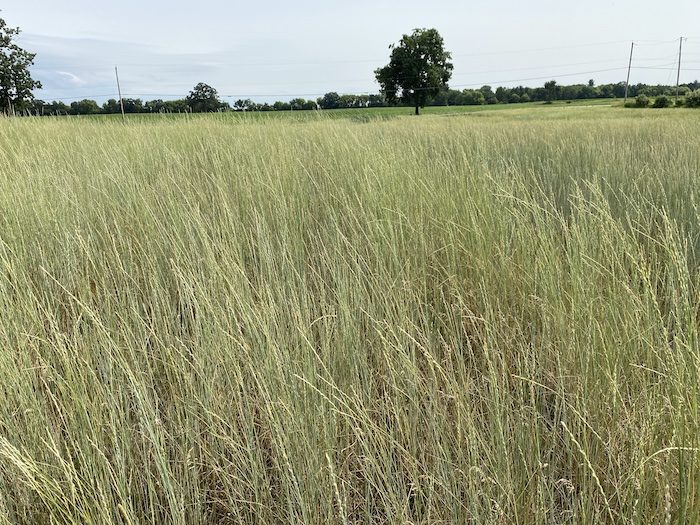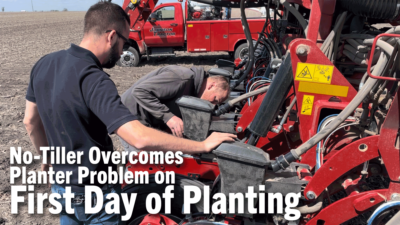The dream of a cool-season perennial grain crop for no-tillers to add to their rotations is not far away. Researchers are working on breeding Kernza, a cool-season perennial crop for human consumption. An amalgamation of “kernel” and “Konza,” in recognition of the Konza Prairie Biological Station in Kansas, this intermediate wheatgrass can be managed for both winter grazing and a grain crop the following summer.
Alfalfa Replacement
Nicole Tautges, who works as an agroecology program director at the Michael Fields Agriculture Institute, is researching no-till Kernza in East Troy, Wis. Kernza is the first perennial grass undergoing domestication in the U.S., says Tautges. It may look like standard meadow grass, but Kernza has been selected for increased grain size and other domesticated traits, such as non-shattering and free-threshing. It is native to Turkey, Afghanistan and Russia.
"Intermediate wheatgrass was selected as a candidate for domestication out of many different perennial grasses because it already has larger seed sizes and already tastes good," Tautges says. "We talk about the dream of perennial agriculture. No-tillers are already very familiar with the harm that repeated tillage can do to soil and our ecosystems, so we're thinking about conservation agriculture. What better way to do that than a perennial crop?"
The primary goal for the breeding program is to increase yields enough to make Kernza an economically viable crop that could be added to a corn and soybean rotation.
"The idea is that we can rotate Kernza with our high-yielding annual crops, give our soil a rest and give ourselves a rest," Tautges says. "It being a perennial saves a lot of labor and time. We see this as being something that can replace what alfalfa was historically in rotations with corn and soybeans."
Kernza is planted once and then produces 3-4 green harvests with just 2 passes across the field each year, one for fertilizing and one for harvesting. The Land Institute has done about 4-5 breeding cycles so far to improve yields, but Kernza still only yields about 800 pounds per acre, about 20% of a typical wheat yield. However, Tautges says yields will improve quickly as the breeding programs increase yield at about 11% per year.
But for now, Tautges says the no-tiller most suitable for Kernza at the moment is someone with smaller acreage and looking to experiment, rather than make an immediate profit.
"Really you only do this if you're the kind of person who's an early adopter, willing to do a lot of extra legwork and you really believe in perennial agriculture," Tautges says.
Kernza Management
The seeding rate for the Kernza is between 12-18 pounds per acre with seed costing about $1 per pound, according to Tautges. Seeding should be done with a regular small grains drill.
"It's incredibly low maintenance, but establishment can be trickly," Tautges says. "It's just like alfalfa — it's really wimpy and puny. You really need to get a fine, nice seed bed. Shallow tilling as you would an alfalfa field is definitely recommended. Some people have no-tilled, and it seems to be really like iffy. We'll probably get there over time, but a lot of agronomic work needs to be done in that space."
Kernza can be grazed or hayed in the fall, making it perfect for integrating livestock, according to Tautges.
"Even if you've grazed it after you've harvested it, you'd have enough to harvest it again the following year," Tautges says, adding that grazing may actually improve yields in the following year. "There's not a significant boost, but at some sites, some years we've seen higher grain yields following grazing compared to non-grazing. We know it doesn't harm yields, and you're getting extra product off your field."
Tautges harvested a crop of Kernza in mid-August. The August harvest timing spreads out the workload for no-tillers who are also growing soybeans and small grains.
Once the Kernza is ready to harvest, farmers can use a regular small grains combine. The hulled kernza will likely need some air to dry down, but Tautges say the grain should be treated the same as oats or other small grains in the bin. Finding a seed cleaner to dehull it can be a challenge, according to Tautges, but needed screen sizes are 3/64, 5/64 and 1 millimeter. Once it is dehulled, the Kernza can go through the same dehuller as oats and then sold to be milled.

Consumer Product
Once the kernza is harvested, it is ground into flour and sold to stores and restaurants. Kernza crackers, noodles, whiskey and beer are proving to be popular products.
"There's a whiskey that was being released by Tattersall in St. Paul, Minn.," Tautges says. "It's also being used in several beers. Lakefront Brewery in Milwaukee is buying my production field Kernza. That was brokered through the cooperative."
Tautges says a market for Kernza had to be created from scratch, but the grain has the potential to be successful commercially with the number of culinary tests that it passed. One of the ways the Land Institute created the market for perennial grain was by reaching out to consumer packaged goods companies to talk about how to incorporate Kernza into their product portfolio. General Mills took a chance on Kernza through their Cascadian Farms brand, but the release was pretty limited and didn't start with total success.
"General Mills only contracted with one grower who had a stand failure," says Tautges. "That's not a way to launch a product."
The lack of resilience in the supply chain is troublesome for trying to sell Kernza, especially when companies are working with 1-2 farmers at a time. It makes it difficult to scale Kernza, says Tautges. In trying to scale it, the Perennial Growers Cooperative is taking it to food shows to scale and market it.
Selling this on the shelves may be trickier given the smaller yield, but Tautges says some farmers view this as an opportunity to hit the reset button.
"Usually farmers are making little to no money on a small grain for feed, but they're putting it in because they get a bump in their corn and soybean yields," Tautges says. "As opposed to growing rye for feed, if you do sell Kernza, you're making way more money. I'm making $400 an acre."
Related Content
Deep-Rooted Kernza Shows Promise as Dual-Purpose Perennial Crop
USDA Funds Project Encouraging Farmers to Grow Kernza
[Podcast] Plant Once, Harvest for Years with Perennial Kernza








Post a comment
Report Abusive Comment